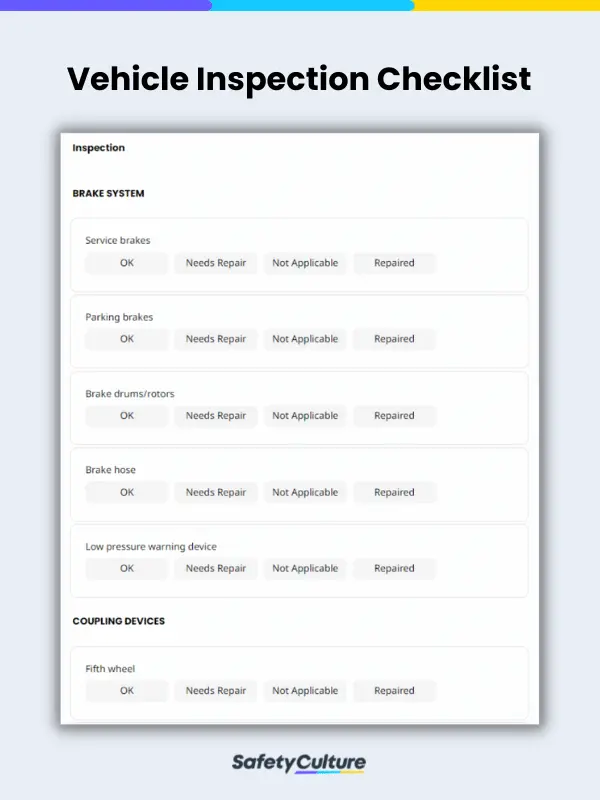What is DVIR?
DVIR, an acronym that stands for Driver Vehicle Inspection Report, is something that all drivers of commercial vehicles need to conduct twice a day. A DVIR consists of a pre-inspection and post-inspection to check the state of the vehicle before and after the trip.
This is to identify safety issues and risks and ensure they are found before they cause damage or accidents. Additionally, these are also there to ensure drivers’ compliance with federal rules and regulations.
This is to identify safety issues and risks and ensure they are found before they cause damage or accidents. Additionally, these are also there to ensure drivers’ compliance with federal rules and regulations.
Why Is It Needed?
To start, a DVIR is required by Federal Law 49 CFR 396.11 and 396.13. These laws are enforced by the United States Department of Transportation (DOT) and the Federal Motor Carrier Safety Administration (FMCSA).
So, drivers of any commercial vehicle must conduct a DVIR to comply with the law. However, this isn’t the only reason that DVIRs are necessary and beneficial to drivers and their organizations.
To start, driving brings many inherent risks, especially when driving commercial vehicles, semi-trucks, cargo vans, motor vans, buses, and similar vehicles. While some risks will always be present, some can be amplified by faulty parts or issues with the vehicle.
DVIRs are supposed to catch any of these risks, issues, and hazards pertaining to the vehicle. It’s important to capture and address any issues with commercial vehicles right away to prevent the risk of accidents that could injure or severely harm employees and cargo.
A DVIR will determine whether or not a vehicle is in good condition to drive. It’s also necessary to determine if the vehicle sustained any damage or developed any issues during the trip. That way, the current state of the vehicle is always known, and there aren’t any unseen hazards that can put drivers, the public, and the cargo in danger.
What Should a DVIR Cover?
DVIRs may vary from vehicle to vehicle. Every commercial vehicle may have its own unique features and components that may need pre-trip inspection and an after trip. However, here are some of the common components that drivers need to do when conducting a DVIR:
- The vehicle’s braking system
- The air system
- Steering mechanism and related components
- The safety and emergency equipment in the vehicle
- Rearview mirror
- Windshield wipers
- Lights and reflectors
- Tires, wheels, and rims
- Coupling equipment and fifth wheels
Since DVIRs can vary depending on the organization and the vehicles they use, it’s important to create customized vehicle inspection checklists that cover specific needs and concerns when operating the company’s vehicles. That way, organizations can make sure they conduct comprehensive inspections and develop accurate reports.
How to Conduct Driver Vehicle Inspections
As mentioned earlier, a DVIR may vary depending on the organization, type of vehicle, and other factors. However, most DVIRs follow four basic steps in checking the safety of a vehicle and determining any hazards. These steps include:
Vehicle Inspection
This is the first step in the DVIR. Drivers must do a 360-degree walk-around and inspection of the vehicle, identifying any defects or hazards in the process. Additionally, the driver needs to start the car, checking for brakes, lights, and other aspects of the vehicle.
To do a comprehensive inspection, drivers must have a DVIR checklist with them that contains all the steps to the inspection, including which parts of the car need to be inspected.
Create Your Own DVIR Inspection Checklist
Eliminate manual tasks and streamline your operations.
Get started for FREEReporting Defects
If the driver finds anything that might affect their ability to drive and operate a vehicle or fleet safely, they must report it immediately. The second step of a DVIR is noting any hazard found during the inspection and reporting it.
Signing Off
Before submitting the DVIR to the appropriate safety officer or motor vehicle carrier, the driver must sign off on the report. This is to ensure that they have double-checked the report and attest that all information is accurate.
Taking Corrective Action
If the driver detects and reports any hazards during the DVIR, it’s important to take immediate corrective actions that address the problem. It’s crucial to report and correct any hazards right away to ensure fleet safety and maintain efficiency during operations.
When and to Whom Should You Submit a DVIR?
Under Federal Law 49 CFR 396.13, drivers must conduct two DVIRs per day. The law states that there should be a DVIR before and after the trip, which usually means conducting an inspection at the start and end of the day.
Before going on a trip, drivers are required to do a walk-around inspection. Additionally, at the end of the trip, they also need to do a walk-around to check for any damage sustained or hazards that might have developed during the trip.
Usually, drivers are required to submit the DVIR to the motor carrier, who will then review the report and take any necessary corrective actions.
Tools Used for DVIR
Since DVIRs are very important and need to be conducted regularly, drivers and organizations may benefit from the use of tools when conducting a DVIR. This speeds up the process while also making everything easier and more efficient. Some of the tools you can use for a DVIR include the following:
- Daily DVIR checklists to remind drivers how to conduct a comprehensive inspection
- Electronic devices to create and submit paperless reports
FAQs about DVIRs
Yes, DVIRs are required under Federal Law, and violating the law may result in hefty fines and penalties.
A DVIR checklist is a comprehensive list of everything a driver needs to check and inspect when conducting the DVIR to ensure that they leave no stone unturned.
Drivers of all commercial vehicles, such as cargo trucks and buses that carry nine or more passengers, must conduct a DVIR before and after the trip.
The drivers are responsible for conducting a DVIR and checking the safety of their vehicles before and after their trips.





